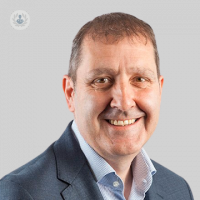Sciatica: Symptoms, treatment and prevention
Written by:Although it usually resolves within several weeks or months, sciatic pain can greatly disrupt your ability to perform day to day tasks. In this informative article, highly respected consultant orthopaedic spinal surgeon Mr Ashley Cole reveals how sciatic pain is diagnosed and the most common symptoms patients typically experience. The leading specialist also shares key insight on how to prevent sciatica and the treatment options available.

What is sciatica?
Sciatica is a severe pain that radiates from the back into the hip and outer side of the leg caused by compression of the sciatic nerve. Along with this radiating pain, patients often experience leg pain which is more common on the inner side of the thigh, lower back pain and numbness or difficulty while moving the leg. Sciatic pain is often worse when sitting and can also cause a tingling sensation along the thigh and leg.
What are the most common causes of sciatica?
The most common cause of sciatica is a slipped disc that results in compression of the sciatic nerve causing pain. Less commonly, sciatica can be linked to pregnancy or conditions such as lumbar spinal stenosis, spondylolisthesis and piriformis syndrome. Risk factors associated with sciatica include:
- age (common among elderly persons)
- diabetes
- being overweight
- wearing high heels
- smoking
- sleeping on a mattress which is too soft or excessively hard
How is sciatica diagnosed?
Sciatica is mainly diagnosed by taking a history and performing a physical examination. When patients present with a radiating pain in the leg, we ask them to report the distribution of the pain and whether it radiates below the knee. We may also check muscle strength and reflexes. People with severe pain or pain that doesn’t improve within a few weeks may need an X-ray of the spine or MRI.
How is sciatica treated?
Most cases of sciatica resolve spontaneously over weeks to months. To reduce pain, hot or cold packs and stretching may be beneficial. Anti-inflammatory medications such as Aspirin, Celecoxib, and Diclofenac, or muscle relaxants can be also helpful in relieving discomfort. In severe cases, a surgical procedure involving decompression of the nerve root may be performed.
Is it possible to prevent sciatica?
Sciatica can be prevented by performing regular exercise, maintaining proper posture while sitting and avoiding heavy weight lifting. Aerobic exercise such as walking, jogging, swimming and cycling can help strengthen the back muscles and improve flexibility. Strengthening the core muscles can also improve spinal health. It’s also advised to avoid sitting for long periods of time and to take frequent breaks to stretch or walk around.
If you would like to schedule a consultation with Mr Cole, you can do so by visiting his Top Doctors profile.


